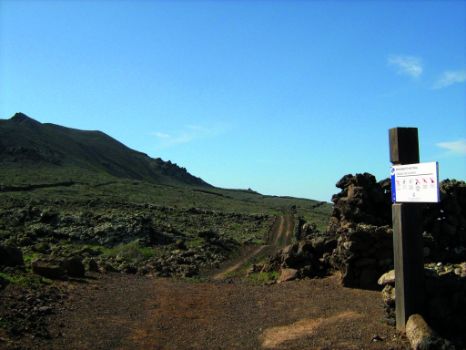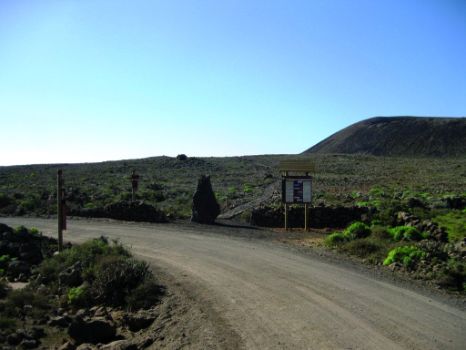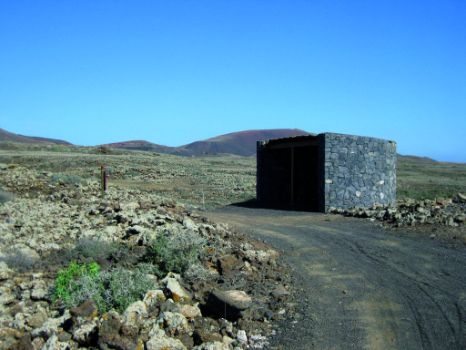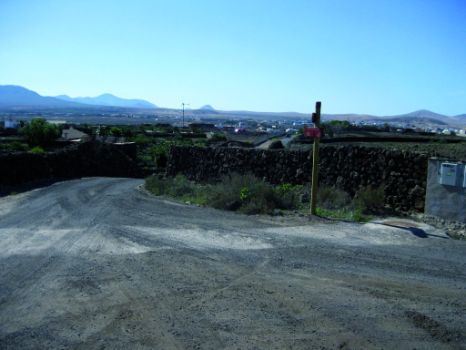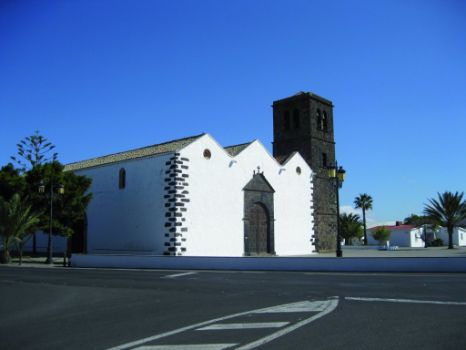Net of Natural
Trails

Stage 2: Corralejo - La Oliva
Description
Through the Badlands of Malpaís de la Arena
From the center of the village of Corralejo, the road takes us into the volcanic natural landscape of Fuerteventura, through volcano cones and calderas, and other debris originated in different eruptions; of particular note is the natural monument Malpaís de la Arena, a beautiful lava field stretching toward Lajares and La Oliva, where this section of the trail comes to its end.
This stretch of the trail begins in Corralejo, one of the great tourist resorts of Fuerteventura. It has been inhabited only in recent times, since this site could not even be considered a fishing village until the nineteenth century. Previously, Corralejo was just a temporary settlement for the people of the island, whose main occupation was fishing and shellfish-gathering.

At the beginning, the trail goes across the town center of Corralejo. From Plaza de Patricio Calero, the oldest square in Corralejo, we take Lepanto Street to Juan Carlos I avenue and, in a southerly direction, we reach the Estrella del Norte roundabout, where the road takes a turn towards Morro Francisco. From here, the trail follows dirt tracks.
Once past Morro Francisco, we can see in this section of the trail the traditional cultivation techniques developed in Fuerteventura. Sand culture (arenado) is a dry farming technique whereby dry stone enclosures are used to protect plants from the livestock, mainly goats, grazing freely in the mountain. Contrary to appearances, fishing did not become an important activity on the island until the early nineteenth century, since the economy of the island was mainly based on livestock farming and agriculture.

We continue along the trail, entering the volcanic landscape of Fuerteventura, an area where we can see several calderas left by different eruptions. In the first leg of the section, before reaching the village of Lajares, we can see various volcanic cones – belonging to the Bayuyo group, originated in the Pleistocene - as well as the wide lava fields that originated the “malpaíses” or badlands in this part of the island.
Once past Caldera Encantada (Enchanted Caldera), between Caldera Rebanada (Sliced Caldera) and Calderón Hondo (Big Deep Caldera), we reach a junction that is the starting point of the SL FV 2 trail, which heads out to Calderón Hondo and continues toward Lajares, where another junction connects back with GR-131 at the outskirts of the village. About 2.5 km before reaching Lajares, we find a stone resting area that serves as a shelter, with two tables and wooden benches inside.

We pass through Lajares, a small Majorera (Fuerteventura) village in the municipality of La Oliva, with a population of just 500, located on a plain dotted with windmills (some of them still in working order), and surrounded by cultivated fields separated by walls made of dry stones, which are often the same dry stones used in the construction of the houses of the village. Of particular note is also the presence of camels, even today used as pack or plowing animals. We continue south along the dirt road, past the ecological farm El Mojón de Matías and various crop lands, until we reach another resting area of the same characteristics as the one described above.
In this leg of the trail we can see the traditional “gavias” or ditches, a cultivation system based on the flooding of a plot surrounded by stone or dirt walls. In the course of our tour, we will continue to see this kind of water management structure – developed on the island of Fuerteventura as a response to water shortages due to low rainfall – on both sides of the trail.

The trail continues on a dirt track along the hillside of Tejate and, soon after, it skirts Montaña de la Arena (Sand Mountain) going through its corresponding badlands, the natural monument Malpaís de la Arena, with Montaña de la Arena on the right.
Once we have skirted Montaña de la Arena, we reach the foot of Montaña de los Saltos (Mountain of the Jumps), leaving the mountain behind us on the left; from here we can begin to see several mills that indicate us that we are nearing the village of La Oliva. The trail also follows the foot of Montaña de la Oliva (La Oliva Mountain), where the above mentioned mills are located.
Then we enter the Natural Monument Malpaís de la Arena (Badlands of the Sand) from its southern tip, in the direction of La Oliva. The trail continues along a path with stones to mark the edges, and then along a track until we arrive squarely to the main road, at the entrance to the village.

Upon entering the urban area of La Oliva, there stands out Casa del Inglés (Englishman’s House) to the right, which is a fine example of civil architecture built for a wealthy family, highlighted by the presence of battlements crowning the building, an architectural element of military origin which was used in Fuerteventura as decoration and as a mark of power and distinction in imitation of the buildings of the lords of the island.
This part of the trail ends at the square in front of the church of Nuestra Señora de Candelaria, in whose presbytery are exposed paintings by Juan de Miranda, which are among the most important art pieces preserved in Fuerteventura. The city hall also stands in the square.
La Oliva is the administrative center of the north of the island, and the famous Casa de los Coroneles (House of the Colonels), recently restored, also belongs to this municipality. Behind the church we can visit the Museum Grano La Cilla, dedicated to the agriculture of the island. Other landmarks we can enjoy in La Oliva are the Centro de Arte Canario Casa Mané (Casa Mané Canary Island Art Centre), the Casa del Capellán (House of the Chaplain), and the arts and crafts centre Monasterio.
Puntos de interés
Culture
Municipality
Orography
Profile
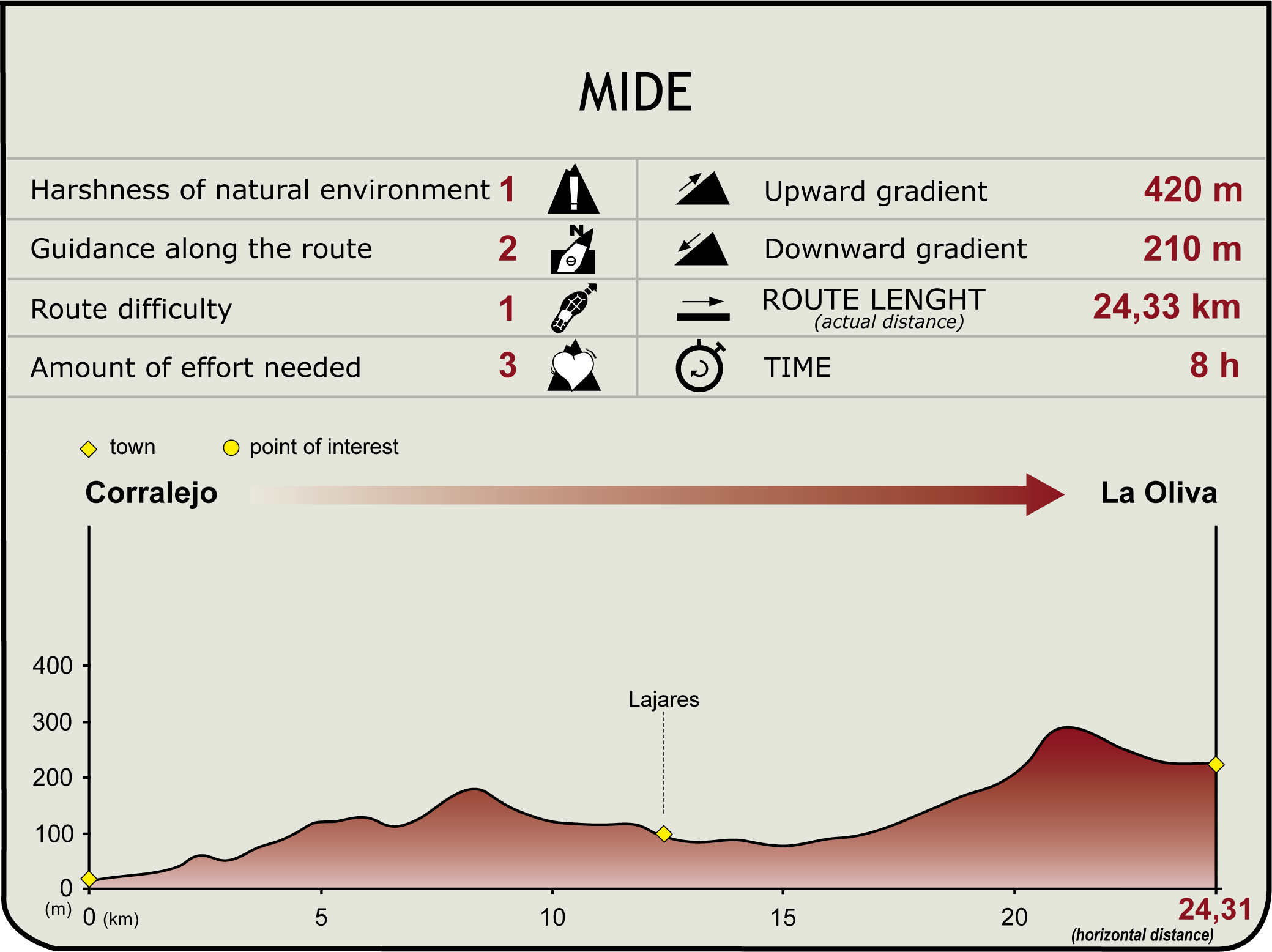
(Calculated according to the MIDE criteria for an average excursionist with a light load)
Highlights
Further infomation
Natural Monument Malpaís de la Arena
Montaña de la Arena, about 420 m high, is a vestige of the last volcanic movements recorded in Fuerteventura. Less than 10,000 years old, this volcano is the most recent on the island. One of its last eruptions gave rise to the badlands or Malpaís de la Arena, a region with an area of 810 ha which was created by the progress of lava streams towards Lajares and La Oliva.
Volcano of la Arena and the lava fields associated with it form a Natural Monument of high geological, geomorphological and scenic interest, which belongs to the Canary Islands Network of Protected Natural Spaces. It is a beautiful region - full of strange shapes and contours - that has been preserved virtually intact.
Although the vegetation here is poorly developed, you can find in these lava fields some of the more robust specimens of “tabaibas” (Euphorbia sp.), Aulagas or spiny broom (Calicotome spinosa) and lichens in the whole Canary Islands. The fauna is mainly represented by reptiles, even though there are some interesting bird species, such as the Canary Islands Stonechat (Saxicola dacotiae), the Berthelot's Pipit (Anthus berthelotii) and the Southern Grey Shrike (Lanius excubitor koenigi).
Casa de los Coroneles
The House of the Colonels (Casa de los Coroneles) is located smack in the middle of a vast plain south of the town of La Oliva, where it stands out because of its sheer size. It is a military architectonic complex dating back to the eighteenth century and consisting of a large Canary style mansion or manor house, a Plaza de Armas or parade square and a number of adjacent buildings which served as servants’ quarters, as well as stables and a cistern, in a predominantly agricultural environment. The building’s floor plan is rectangular, and the house has two floors; two crenellated sections on the sides of the facade are particularly noteworthy.
This stately house is of historical significance for Fuerteventura from an economic and social standpoint in that it was the official residence of the military oligarchs who ruled the island. The foundations of this civil and military architectural complex were laid in the second half of the seventeenth century, the building having been commissioned by the Cabrera Bethencourt family; its construction is attributed to Ginés de Bethencourt Cabrera (1650-1722), and his descendants carried on the work after him, particularly his grandson, Agustin Cabrera Bethencourt Dumpiérrez ¸ (1743-1828), fifth colonel of the island.
The institution of Colonel appears in Fuerteventura with the creation of the militias in 1708. The first colonel of militia was Don Pedro Sánchez de Dumpiérrez. The power on the island was in the hands of the Arias de Saavedra family, and the Lordship of Fuerteventura was transmitted from generation to generation within the family. The Lords did not reside on the island, having established their residence on Tenerife. In this context, military power, which was in the hands of the Lords, was gradually transferred to the Colonels.
From the eighteenth century, the Colonels became the true landlords of Fuerteventura and their appointment came to be both hereditary and for life. Since then they held both military and civil powers, appointing and dismissing the officials working for the Cabildo or Council. The slow decline of this institution took place over the nineteenth century, with the advent of a new political and socioeconomic situation, but in spite of the fact that they largely lost their political and military authority, they still managed to cling to some measure of economic power, even after the post of colonel disappeared.



